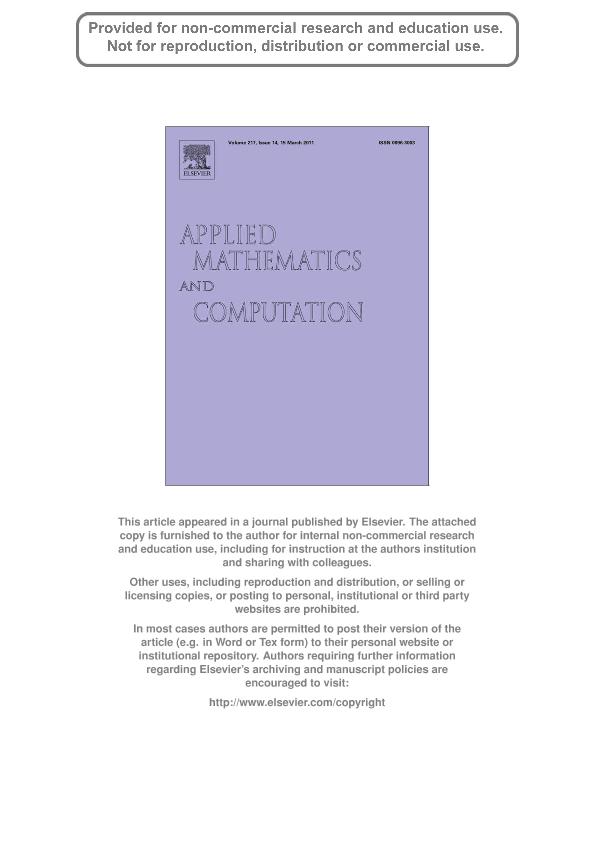Mostrar el registro sencillo del ítem
dc.contributor.author
Febbo, Mariano

dc.date.available
2019-01-07T19:38:43Z
dc.date.issued
2011-03
dc.identifier.citation
Febbo, Mariano; A finite extensibility nonlinear oscillator; Elsevier Science Inc; Applied Mathematics and Computation; 217; 14; 3-2011; 6464-6475
dc.identifier.issn
0096-3003
dc.identifier.uri
http://hdl.handle.net/11336/67610
dc.description.abstract
The dynamics of a finite extensibility nonlinear oscillator (FENO) is studied analytically by means of two different approaches: a generalized decomposition method (GDM) and a linearized harmonic balance procedure (LHB). From both approaches, analytical approximations to the frequency of oscillation and periodic solutions are obtained, which are valid for a large range of amplitudes of oscillation. Within the generalized decomposition method, two different versions are presented, which provide different kinds of approximate analytical solutions. In the first version, it is shown that the truncation of the perturbation solution up to the third order provides a remarkable degree of accuracy for almost the whole range of amplitudes. The second version, which expands the nonlinear term in Taylor's series around the equilibrium point, exhibits a little lower degree of accuracy, but it supplies an infinite series as the approximate solution. On the other hand, a linearized harmonic balance method is also employed, and the comparison between the approximate period and the exact one (numerically calculated) is slightly better than that obtained by both versions of the GDM. In general, the agreement between the results obtained by the three methods and the exact solution (numerically integrated) for amplitudes (A) between 0 < A ≤ 0.9 is very good both for the period and the amplitude of oscillation. For the rest of the amplitude range (0.9 < A < 1), an exponentially large L2 error demonstrates that all three approximations do not represent a good description for the FENO, and higher order perturbation solutions are needed instead. As a complement, very accurate asymptotic representations of the period are provided for the whole range of amplitudes of oscillation. © 2011 Elsevier Inc. All rights reserved.
dc.format
application/pdf
dc.language.iso
eng
dc.publisher
Elsevier Science Inc

dc.rights
info:eu-repo/semantics/openAccess
dc.rights.uri
https://creativecommons.org/licenses/by-nc-sa/2.5/ar/
dc.subject
Finite Extensibility
dc.subject
Nonlinear Oscillator
dc.subject.classification
Astronomía

dc.subject.classification
Ciencias Físicas

dc.subject.classification
CIENCIAS NATURALES Y EXACTAS

dc.title
A finite extensibility nonlinear oscillator
dc.type
info:eu-repo/semantics/article
dc.type
info:ar-repo/semantics/artículo
dc.type
info:eu-repo/semantics/publishedVersion
dc.date.updated
2019-01-02T18:20:17Z
dc.journal.volume
217
dc.journal.number
14
dc.journal.pagination
6464-6475
dc.journal.pais
Estados Unidos

dc.journal.ciudad
Nueva York
dc.description.fil
Fil: Febbo, Mariano. Consejo Nacional de Investigaciones Científicas y Técnicas. Centro Científico Tecnológico Conicet - Bahía Blanca. Instituto de Física del Sur. Universidad Nacional del Sur. Departamento de Física. Instituto de Física del Sur; Argentina. Universidad Nacional del Sur. Departamento de Física; Argentina
dc.journal.title
Applied Mathematics and Computation

dc.relation.alternativeid
info:eu-repo/semantics/altIdentifier/doi/https://doi.org/10.1016/j.amc.2011.01.011
dc.relation.alternativeid
info:eu-repo/semantics/altIdentifier/url/https://www.sciencedirect.com/science/article/pii/S0096300311000257
Archivos asociados
